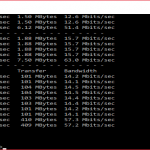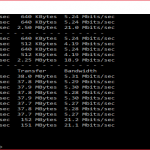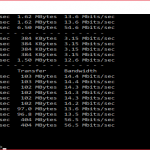We tried to replicate the testing from our Ultimate Mesh WiFi Router Shootout as closely as possible with the ASUS Lyra Trio. However, we no longer had the Apple Macbook Pro in our possession, so had to leave this set of tests out.
We replicated the positions from the Ultimate Mesh WiFi Router Shootout, with eight different locations for our test notebooks. The clients used were an HP Spectre 13 X2 notebook with 2×2 802.11ac WiFi, and an older HP Folio 13 which maxes out at 3×3 802.11n WiFi.
In each case, we used the freely available iPerf 3.1.3 software, which stresses a network by sending packets of random data and measures the throughput. One system acts as a server, and the other as a client, as data is sent between them. In all cases, we used an Armari Windows 10 workstation connected to the primary Lyra unit via Gigabit Ethernet as the server, so that the WiFi was always the slowest connection.
These are the iPerf commands we used:
For the server: iperf3 –s –i 1
For the client: iperf3 –c <IP Address> –P 4 –i 1 –t 60
Note that the client command sends four streams of data simultaneously, simulating a multi-client connection as closely as possible with just one client. It takes 60 throughput readings at one second intervals and then averages the result.
The above diagram shows the layout of the house we used for testing. Note that we didn't test on the top floor of the house because this was directly above the first floor and wouldn't have provided much of a range test. Instead, we used two locations on the same floor as the router (the first floor), then more distant locations on the ground floor extending out the back of the house into the garden.
Each test location, numbered in the diagram above, was approximately 5m away from the last one.
With the mesh networking and standalone router products used for comparison, location 1 was very near to the router, around 1m away. The next location – 2 – was around 5m away, with a wall in the way, but on the same floor. Location 3 was on the floor below, so had walls and a floor in between, but was a further 5m away. Location 4 was the last one actually inside the house. Locations 5 to 7 were then 5m further down the garden. Location 8 was only 2m further down, as this was the end of the garden, but also behind a shed, so posed a significant challenge that only a few mesh WiFi systems can cope with.
We should also say a few words about the location of the satellites. The routers or primary unit were always placed in the same location, in the first floor study next to the broadband. In the case of three-unit mesh systems such as BT Whole Home Wi-Fi and the top Velop option, the second and third satellites were placed at S1 and S2.
With the two-unit Google WiFi, the second unit was placed at S1, due to the recommendation of the setup software. However, in the case of the Orbi, it was possible to place the second unit at S2, due to the signal strength from these systems.
For the ASUS Lyra Trio system, we placed the primary unit in location R, with the first satellite at S1, and the second at S2.
802.11ac 5GHz
Within 1m, the Lyra Trio is not that fast, perhaps because our test 802.11ac notebook only has 2×2 antennas (which is still normal for most notebooks). It's still slow at 5m, although faster than Google WiFi and the atrocious Tenda nova MW6. At 10m, performance has dropped, but not as much as many others, making its 72.4Mbits/sec the sixth fastest mesh speed we have tested at this distance.
Unfortunately, performance does drop off at 15m, with 35.5Mbits/sec placing in the pack for mesh systems not made by NETGEAR, or ASUS's other mesh options. The 20m result is relatively similar to 15m, with a usable 17.4Mbits/sec bandwidth but most alternative mesh systems being a bit quicker. The Lyra Trio just about holds up at 25m, although 10.1Mbits/sec is only marginably usable.
At 30m and beyond, the Lyra Trio is transferring some data, but not enough to be really worthwhile.
Overall, with an 802.11ac client you are getting extended range over a regular router, but not as much as the premium mesh systems from NETGEAR and ASUS. Interestingly, ASUS AiMesh fares much better at all distances too. Most significantly, BT's sub-£200 Whole Home WiFi offers a bit more usable range for less money.
802.11n 2.4GHz
The 2.4GHz 802.11n results are a very different story. At 1m, the Lyra Trio is merely average, offering 56.5Mbits/sec. However, performance actually improves slightly to 59Mbits/sec at 5m. This places much higher in the pack of mesh options, and the story continues at 10m, with 41.9Mbits/sec.
The Lyra Trio actually posts ists fastest 802.11n result at 15m, hitting 61.7Mbits/sec, which is the fifth fastest mesh system we have tested at this range. This position is maintained at 20m, with 43.8Mbits/sec. At 25m performance actually goes up again to 57.3Mbits/sec, which moves the Lyra Trio up to third fastest mesh system.
Amazingly, the Lyra Trio keeps its third position at 30m, and even manages 5Mbits/sec at 32m, which is actually behind a shed so most systems fail to reach this distance. Even ASUS's original Lyra failed this last distance.
It's worth noting that our test notebook has a 3×3 802.11n antenna configuration, which will have helped performance in this test. But this is still one of the best performances we have seen from a mesh system over 802.11n, and all previous mesh systems were tested using the same notebook.
Overall, the ASUS Lyra Trio provides decent mesh performance. In 802.11n, it's one of the best we've seen, but in 802.11ac it merely extends range over a standalone router. Unfortunately, this means that there are better mesh alternatives for performance, and whilst most are more expensive than the Lyra Trio, BT's Whole Home WiFi is actually cheaper.
 KitGuru KitGuru.net – Tech News | Hardware News | Hardware Reviews | IOS | Mobile | Gaming | Graphics Cards
KitGuru KitGuru.net – Tech News | Hardware News | Hardware Reviews | IOS | Mobile | Gaming | Graphics Cards





















